Lovebluesky.com
A Lifestyle You'll
Love Waking Up To

The Amazing Benefits of Japan’s Hot Springs
Table of Contents
What Is Onsen?
According to Japanese law, onsen refers to water that comes from deep underground, heated naturally by volcanic activity. For water to be classified as onsen, it must be at least 25°C when it comes out of the ground. If it’s below that temperature, it needs to contain at least one of 19 minerals in specific amounts to qualify. That means every onsen you visit is packed with minerals like sulfur, iron, and salt, each offering its own health benefits.
Onsens can be found throughout Japan, from remote mountain towns to bustling cities, and each one offers a unique experience. Whether it’s an outdoor bath in the midst of nature or a sleek, modern indoor bath, the essence of onsen remains the same—offering a chance to immerse in nature, experience wellness, and embrace the soothing heat of the water.
The Health Benefits of Soaking in an Onsen
Stress Relief and Relaxation
One of the most immediate benefits you’ll experience is stress relief. Soaking in warm water helps your body release tension, both physically and mentally. The warmth stimulates the production of endorphins, your body’s natural “feel-good” chemicals, which can help reduce anxiety and promote a sense of calm. It’s like having a mini-spa day, but with the added bonus of being surrounded by nature.
Eases Muscle and Joint Pain
If you’re someone who suffers from muscle aches, stiffness, or joint pain, an onsen can be a game-changer. The warmth of the water helps increase blood circulation, which in turn promotes healing by delivering more oxygen and nutrients to sore muscles. Certain minerals found in onsen water, like sulfur, are particularly effective in easing arthritis and rheumatism. Whether you’re recovering from a long hike or just dealing with the aches of everyday life, an onsen soak can be incredibly therapeutic.
Skin Benefits: The Natural Spa Treatment
Onsen water is rich in minerals, which can do wonders for your skin. Many people visit onsens specifically for their skin-healing properties. Sulfur in particular is known to help with acne, eczema, and dry skin by unclogging pores and promoting healthy circulation. It’s like a natural facial! After a good soak, you may notice smoother, more vibrant skin—making onsens a popular beauty treatment among both locals and visitors alike.
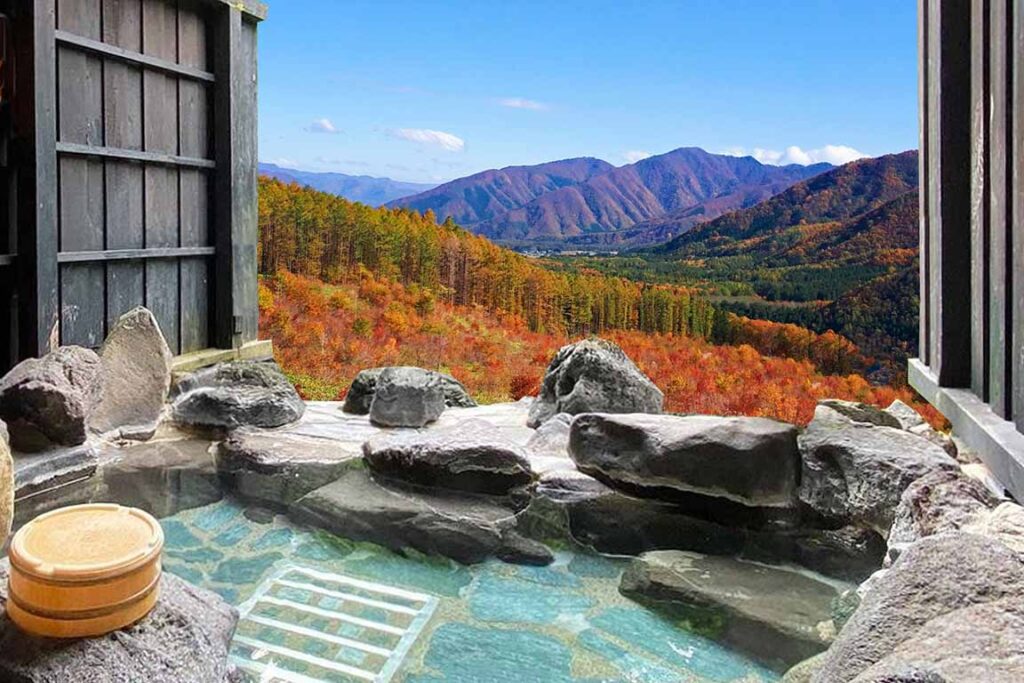
Detoxification and Improved Circulation
Soaking in onsen water isn’t just about relaxation; it also helps your body get rid of toxins. The warm water induces sweating, which helps flush out harmful substances from your body. At the same time, the minerals in the water support the detoxification process. The heat also boosts circulation, improving oxygen flow and helping the body rid itself of waste products. This combination of sweat, minerals, and improved circulation leaves you feeling revitalized and refreshed.
Boosts the Immune System
Believe it or not, regular onsen visits may also have a positive effect on your immune system. The combination of heat, relaxation, and minerals found in the water can help your body fight off common colds and illnesses. The improved circulation helps white blood cells travel throughout your body more efficiently, boosting your body’s natural defenses. So not only are you relaxing, but you’re giving your immune system a little extra help, too.
The 10 Types of Onsen and Their Unique Health Benefits
Let’s take a closer look at the 10 types of onsen you can find across Japan, and the health benefits they provide. No matter what health benefits you’re looking for, there’s an onsen in Japan that’s perfect for you.
1. Simple Spring
This onsen contains water with minimal mineral content. It’s typically neutral in pH and has a mild, soothing effect.
Health Benefits: The gentle nature of simple spring water makes it perfect for overall relaxation and stress relief.
2. Chloride Spring
Rich in chloride ions, this type of onsen is known for its salty and mineral-rich waters.
Health Benefits: Chloride-rich water is known for its ability to retain heat and enhance blood circulation, making it ideal for treating cold sensitivity and muscle pain. It also helps moisturize the skin, so it’s great for people dealing with dry skin or eczema.
3. Bicarbonate Spring
This onsen is rich in bicarbonate ions, which give the water a slightly alkaline nature.
Health Benefits: Bicarbonate springs are famous for their skin rejuvenating properties. The water helps soften and smooth the skin, making it a popular choice for beauty treatments. It’s also said to help reduce the appearance of wrinkles and improve circulation.
4. Sulfate Spring
This onsen contains sulfate minerals like magnesium sulfate and calcium sulfate, which give the water a slightly cloudy appearance.
Health Benefits: Sulfate springs are known for their detoxifying properties. The minerals in the water help to flush out toxins from the body and promote healthy skin. This type of onsen is also beneficial for those with stomach ailments or digestive issues, as the water helps stimulate digestion and improve metabolism.
5. Carbon Dioxide Spring
As the name suggests, these onsens are rich in carbon dioxide gas, which gives the water a slightly effervescent quality.
Health Benefits: Soaking in carbon dioxide springs helps improve blood circulation by stimulating the body’s natural ability to absorb oxygen. This can be especially beneficial for people suffering from high blood pressure, fatigue, or poor circulation.
6. Iron Spring
Iron-rich water gives this onsen a distinctive reddish-brown color, thanks to the high iron content.
Health Benefits: It helps improve oxygen flow in the blood, promoting overall vitality.
7. Acidic Spring
This onsen has a low pH and contains high levels of hydrogen ions, making it one of the most potent types of onsen.
Health Benefits: The acidic properties of this water make it a powerful tool for skin treatments. It helps to cleanse the skin, remove dead cells, and is known to improve conditions like acne and eczema. The strong acidity can also provide relief for respiratory conditions and infections.
8. Iodine Spring
Iodine springs contain high levels of iodine, which is an essential element for the body’s thyroid function.
Health Benefits: Iodine springs are especially beneficial for treating skin infections, wounds, and inflammation. Regular soaks in iodine-rich water are also said to help improve thyroid health and metabolism.
9. Sulfur Spring
Known for its distinctive sulfur smell, this onsen contains high concentrations of sulfur and is often characterized by its cloudy, yellowish appearance.
Health Benefits: Sulfur springs are famous for their anti-inflammatory and antibacterial properties. They’re great for treating skin conditions like psoriasis, eczema, and acne. The sulfur helps detoxify the body and promote healing of muscle pain and joint pain.
10. Radioactive Spring
These onsens contain radon gas, which gives them a slight radioactive quality. While this might sound a bit alarming, it’s been used in traditional healing for centuries.
Health Benefits: Radon springs are believed to promote cell regeneration and detoxification. Regular exposure to the mild levels of radon in the water is said to help improve circulation, stimulate the immune system, and even provide relief for chronic pain and fatigue.
Must-Visit Onsens in Japan
Thanks to its location on the Pacific Ring of Fire, Japan is home to over 100 active volcanoes and an abundance of geothermal activity, making it one of the world’s best destinations for natural hot springs.
Whether you’re looking for legendary healing waters, breathtaking scenery, or a deep dive into Japanese history, these five must-visit onsens will take your relaxation to the next level.
1. Kusatsu Onsen (Gunma) – Japan’s Hot Spring Powerhouse
If you’re looking for the strongest onsen in Japan, Kusatsu Onsen is the place to be. With the largest natural hot spring output in the country and water so acidic it can kill bacteria instantly, Kusatsu’s healing reputation is legendary. The town is famous for its Yubatake (literally “hot water field”), a massive wooden structure where steaming water flows through the center of the town, creating an otherworldly atmosphere.
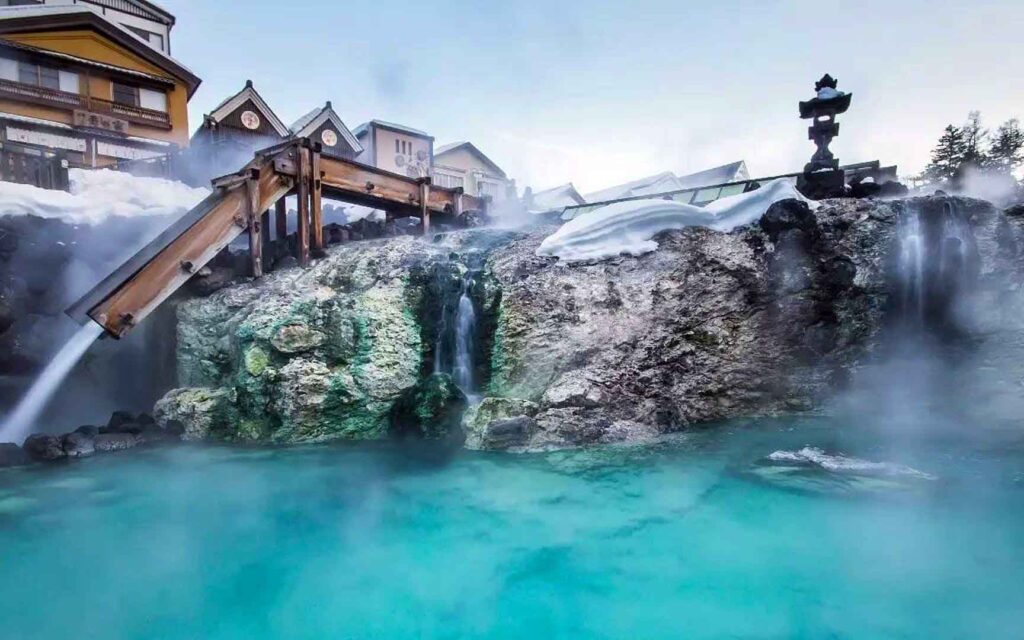
Why visit? Kusatsu’s highly acidic waters are believed to help with skin conditions, muscle pain, and even colds. Plus, the traditional yumomi (a ritual where local women stir the water to cool it down) is a cultural experience you don’t want to miss!
2. Gero Onsen (Gifu) – The “Beauty Bath” of Japan
Ranked as one of Japan’s Three Great Onsens (日本三名泉), Gero Onsen has been a go-to relaxation spot for centuries. The water here is rich in alkaline minerals, making it incredibly smooth and silky on the skin. In fact, many visitors say bathing here feels like being wrapped in liquid silk!
Why visit? If you want soft, glowing skin, Gero Onsen is your dream destination.
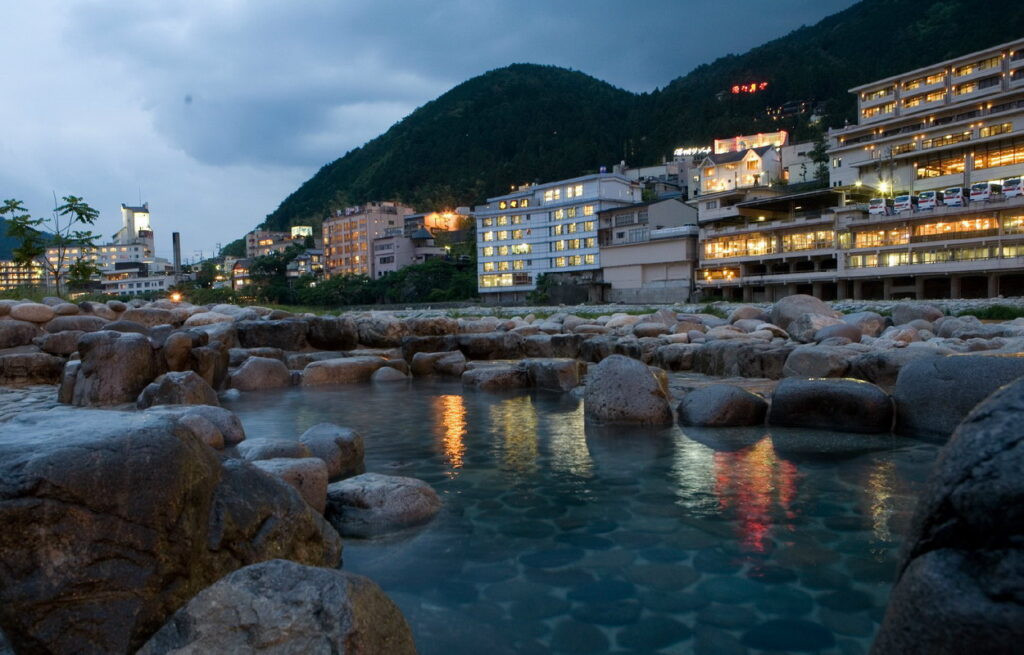
3. Dogo Onsen (Ehime) – Japan’s Oldest Hot Spring Town
Imagine stepping into an onsen straight out of a Ghibli movie—that’s Dogo Onsen. Located in Shikoku, this historic onsen town is said to be over 3,000 years old, making it Japan’s oldest hot spring. The main attraction? Dogo Onsen Honkan, a stunning wooden bathhouse that inspired the bathhouse in Studio Ghibli’s Spirited Away.

Why visit? Besides its legendary history, Dogo Onsen offers gentle, healing waters perfect for first-time bathers. Plus, walking around in a yukata (light cotton kimono) in the charming town streets feels like stepping back in time.
4. Beppu Onsen (Oita) – The Onsen Capital of Japan
If you love variety, Beppu Onsen is the ultimate destination. With over 2,000 hot spring sources, this area produces the largest volume of hot spring water in Japan. Beppu is famous for its “Hells of Beppu” (Jigoku Meguri)—a series of unique hot springs that are too hot to bathe in but fascinating to see, from bright cobalt blue pools to bubbling red clay baths.
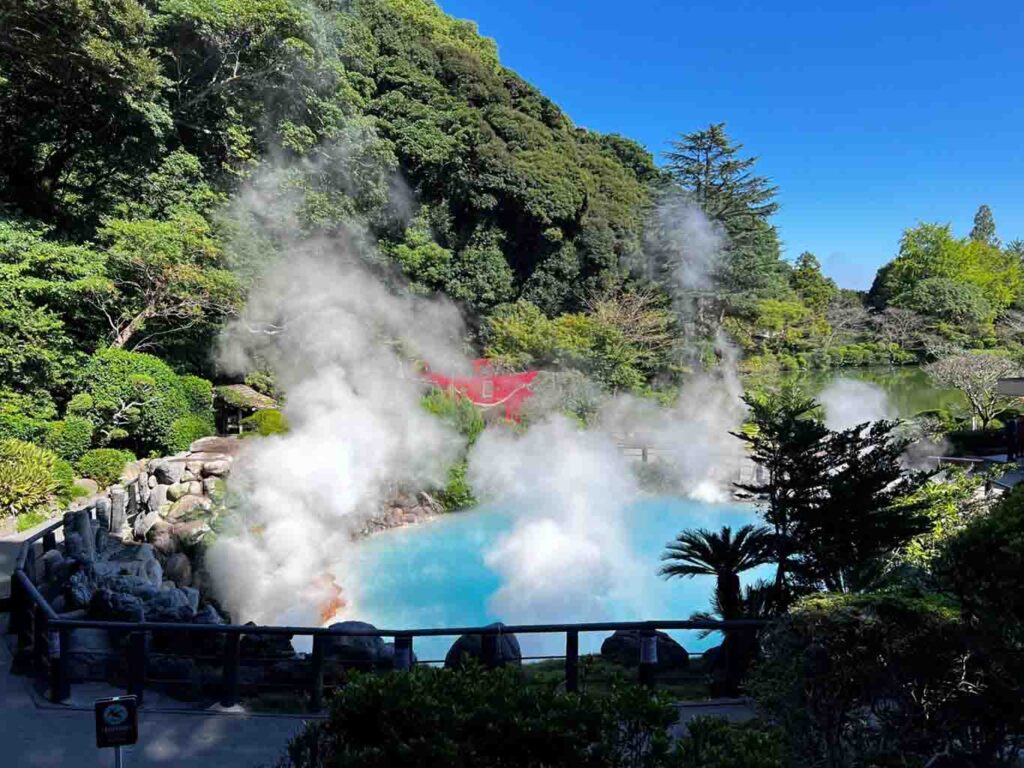
Why visit? Beppu has something for everyone—sand baths, mud baths, steam baths, and even hot spring cooking! For a one-of-a-kind experience, try getting buried in a steaming onsen sand bath at Beppu Beach Sand Bath.
5. Arima Onsen (Hyogo): A Historic Retreat with Golden and Silver Springs
If you’re looking for a hot spring with deep history and unique waters, Arima Onsen is the perfect getaway. Just an hour from Osaka, this charming onsen town has been a retreat for centuries, attracting emperors, samurai, and famous writers seeking inspiration.
Why visit? Arima is famous for its two distinct springs. The “Kin-sen” (Gold Spring) is a reddish-brown, iron-rich water known for its warming and skin-rejuvenating effects, while the “Gin-sen” (Silver Spring) is a clear, radium-infused water believed to improve circulation and relieve fatigue.
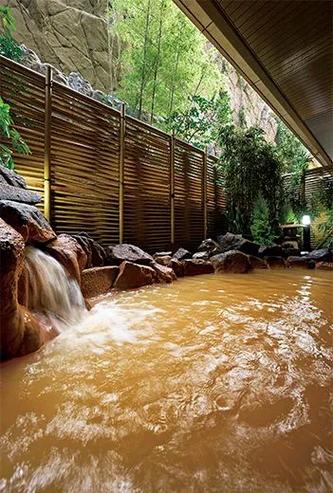
Travel Tips: How to Make the Most of Your Onsen Experience
Best Time to Visit an Onsen
Onsens are a year-round pleasure, but the experience changes with the seasons.
Winter is the most magical time, especially if you visit an outdoor onsen (rotenburo) surrounded by snow. There’s nothing quite like soaking in steamy, mineral-rich water while watching snowflakes gently fall around you.
Spring and autumn offer beautiful scenery, with cherry blossoms in full bloom or vibrant red and yellow foliage creating a picturesque backdrop. These seasons are also great for avoiding the peak winter crowds.
Summer can be refreshing, too—especially in mountainous onsen towns, where the cooler air and warm water create a soothing balance. Some onsens also have lukewarm baths or cooling dips to help beat the summer heat.
What to Pack
Visiting an onsen doesn’t require much, but bringing a few essentials can make your experience smoother.
Most onsens provide soap, shampoo, and towels, but if you prefer, you can bring your own. A small towel is handy for washing and covering yourself when walking between baths, while a larger towel is for drying off afterward.
If you’re staying at a traditional ryokan, many provide a yukata (light cotton kimono) for guests to wear during their stay. It’s not only comfortable but also adds to the authentic onsen experience.
Onsen-Related Activities: Beyond the Bath
An onsen trip isn’t just about soaking in hot water—there’s plenty more to enjoy!
Traditional Ryokan Stay: Staying at a historic ryokan lets you experience kaiseki (traditional multi-course meals) made with seasonal ingredients. Many ryokans also have private baths, perfect for a more secluded soak.
Strolling in Yukata: Many onsen towns have charming streets lined with traditional shops and cafés. Enjoy walking around in a yukata while sampling local treats like onsen manju (steamed buns) , onsen tamago (steamed egg) or stopping by a cozy teahouse.

Onsen Foot Baths: Many onsen towns offer ashiyu (foot baths) in public areas, allowing travelers to relax and enjoy the warm water without fully undressing. These foot baths are perfect for a quick, refreshing stop while exploring.

Traditional Japanese Spa Treatments: Many onsen resorts offer massages, facials, and wellness programs designed to complement the healing effects of the hot springs. Enjoy a shiatsu massage or a rejuvenating facial to complete your relaxation.
Exploring Nature & Culture: Many onsen towns are surrounded by beautiful landscapes. You can find hiking trails, waterfalls, or temples nearby, making your trip a blend of adventure and relaxation.
Experience the Amazing Benefits of Japan’s Hot Springs
From soothing tired muscles to rejuvenating the mind, Japan’s onsens offer the perfect blend of relaxation, history, and culture.
Start planning your trip today and discover the incredible benefits of Japan’s hot springs firsthand!
